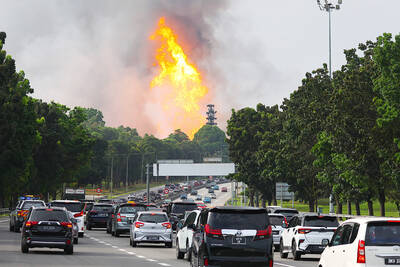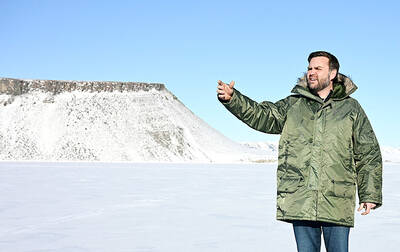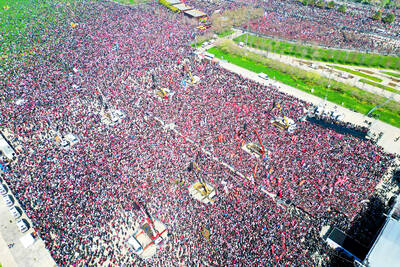Museum authorities at the former Nazi Auschwitz-Birkenau death camp in Poland are struggling to save the enduring symbol of the Holocaust from the impact of time and the elements.
In the drive to stop the site falling into ruin and preserve the memory of the 1.1 million overwhelmingly Jewish victims who died here during World War II, they face tall odds.
“This is our last chance,” said Piotr Cywinski, director of the state-run museum.
The museum keeps going thanks to the Polish government, which covers around half of its costs, plus visitors’ ticket fees. Up to 5 percent of its budget comes from the US-based Lauder Foundation and Germany’s regional governments.
Last month it announced plans for a 120 million euro (US$163 million) appeal to enable it to become self-financing.
Crucially, said Cywinski, it could then set aside some 5 million euros a year for conservation work.
The rudimentary buildings of the camp’s Birkenau site, built by the prisoners on marshy land, are being battered by soil erosion and water damage.
“We have to finish conservation work on all these buildings within 10 to 12 years, so we need to start within three years at the latest,” Cywinski said.
“The primary goal is to preserve the site’s authentic nature and not to rebuild it, in order not to change the perception of this place,” he added.
“But the big question today is: Do we want to save this place?” he said.
Preserving a single barrack-block costs around 880,000 euros, conservation chief Rafal Pioro said.
Warsaw has called on the international community to support the new drive to maintain the camp.
The museum site covers 191 hectares, with 155 buildings and 300 ruins, and has a collection of thousands of personal items, as well as documents exposing the minutiae of the Nazis’ killing machine.
The Nazis initially set up the camp for Polish resistance fighters, nine months after invading Poland in September 1939.
The original camp was at a former Polish army barracks on the edge of the southern town of Oswiecim — known in German as Auschwitz.
Two years later the Nazis greatly expanded the site at nearby Brzezinka, or Birkenau.
Around 1.1 million people died at Auschwitz-Birkenau between 1940 and 1945 — 1 million of them Jews from Poland and elsewhere in Nazi-occupied Europe — some from overwork, starvation and disease, but most in the notorious gas chambers.
It was one of six death camps set up in Poland — home to pre-war Europe’s largest Jewish community — by the occupying Germans, who murdered 6 million Jews during the war.
Non-Jewish Poles, Roma and Soviet POWs were also among the many victims of Auschwitz-Birkenau and the other death camps found in Chelmno, Treblinka, Sobibor, Majdanek and Belzec.
The museum devotes much of its time to protecting the intimate traces of the prisoners’ presence.
Each of the 80,000 shoes stockpiled by the Nazis, for example, is being painstakingly preserved.
“There’s no technical problem to bring back the original beauty of an old shoe, but that would wipe away its entire story,” Cywinski said.
The task of the museum’s laboratories, financed by the Lauder Foundation, is unique.
“There are ways to restore medieval objects, but not to conserve six-decade-old, poor quality plastic toothbrushes ... We don’t have any reference point,” Cywinski said.
Researchers have identified 90 different kinds of ink or pencil on the 40,000 documents left by the Nazi medical service.
Each document with different ink or pencil requires a different conservation method, expert Nel Jastrzebiowska said.
The museum, set up by the Polish government in 1947, last year drew 1.13 million visitors compared to half that in 2001 — crucial for remembrance, but putting extra physical pressure on the site.

A fire caused by a burst gas pipe yesterday spread to several homes and sent a fireball soaring into the sky outside Malaysia’s largest city, injuring more than 100 people. The towering inferno near a gas station in Putra Heights outside Kuala Lumpur was visible for kilometers and lasted for several hours. It happened during a public holiday as Muslims, who are the majority in Malaysia, celebrate the second day of Eid al-Fitr. National oil company Petronas said the fire started at one of its gas pipelines at 8:10am and the affected pipeline was later isolated. Disaster management officials said shutting the

US Vice President J.D. Vance on Friday accused Denmark of not having done enough to protect Greenland, when he visited the strategically placed and resource-rich Danish territory coveted by US President Donald Trump. Vance made his comment during a trip to the Pituffik Space Base in northwestern Greenland, a visit viewed by Copenhagen and Nuuk as a provocation. “Our message to Denmark is very simple: You have not done a good job by the people of Greenland,” Vance told a news conference. “You have under-invested in the people of Greenland, and you have under-invested in the security architecture of this

Japan unveiled a plan on Thursday to evacuate around 120,000 residents and tourists from its southern islets near Taiwan within six days in the event of an “emergency”. The plan was put together as “the security situation surrounding our nation grows severe” and with an “emergency” in mind, the government’s crisis management office said. Exactly what that emergency might be was left unspecified in the plan but it envisages the evacuation of around 120,000 people in five Japanese islets close to Taiwan. China claims Taiwan as part of its territory and has stepped up military pressure in recent years, including

UNREST: The authorities in Turkey arrested 13 Turkish journalists in five days, deported a BBC correspondent and on Thursday arrested a reporter from Sweden Waving flags and chanting slogans, many hundreds of thousands of anti-government demonstrators on Saturday rallied in Istanbul, Turkey, in defence of democracy after the arrest of Istanbul Mayor Ekrem Imamoglu which sparked Turkey’s worst street unrest in more than a decade. Under a cloudless blue sky, vast crowds gathered in Maltepe on the Asian side of Turkey’s biggest city on the eve of the Eid al-Fitr celebration which started yesterday, marking the end of Ramadan. Ozgur Ozel, chairman of the main opposition Republican People’s Party (CHP), which organized the rally, said there were 2.2 million people in the crowd, but